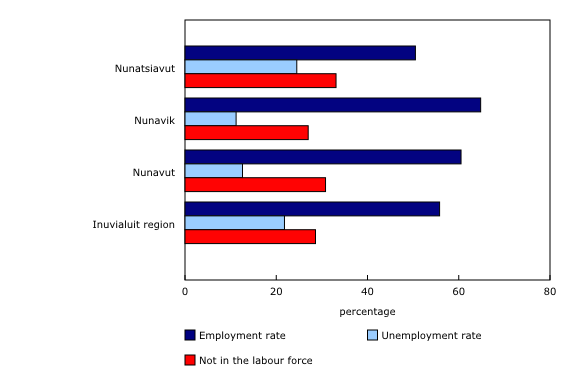Inuit participation in the wage and land-based economies in Inuit Nunangat
Archived Content
Information identified as archived is provided for reference, research or recordkeeping purposes. It is not subject to the Government of Canada Web Standards and has not been altered or updated since it was archived. Please "contact us" to request a format other than those available.
Released: 2019-06-13
The 2017 Aboriginal Peoples Survey (APS) marks the fifth cycle of this national survey of First Nations people living off reserve, Métis and Inuit aged 15 or older. In 2017, the survey focused on participation in the economy. Today, Statistics Canada releases new analyses focusing on employment among First Nations living off-reserve and Métis aged 25 to 54, as well as on Inuit participation in the wage and land-based economies in Inuit Nunangat.
Today's publications build on APS products summarizing key findings from the survey, released on November 26, 2018 (see Daily articles on First Nations people living off reserve, Métis and Inuit).
These early overviews for Inuit were presented in a booklet (see Labour market experiences of Inuit), an infographic (see Harvesting and handicraft activities among Inuit) and an interactive map (see Methods used to look for work, reasons for difficulty finding work, and things that would help find work). Today's analyses place further focus on participation in the economy.
Over the coming months, Statistics Canada will release additional analytical products focusing on key topics of the 2017 APS, including upgrading education and high school equivalency, persons with disabilities and educational attainment in Nunavut.
The vast majority of Inuit aged 25 to 54 living in Inuit Nunangat participate in the land-based economy
Inuit Nunangat is characterized by a unique mixed economy, linking land-based activities with the wage economy. In addition to working for wages, the vast majority of Inuit aged 25 to 54 living in Inuit Nunangat (85%) regularly engage in hunting, fishing, gathering wild plants, or making artwork. Many Inuit benefit from these activities economically.
A new Statistics Canada study released today uses data from the 2017 APS to examine participation in both wage-based and land-based economies among Inuit living in Inuit Nunangat. The results show that it is necessary to move beyond concepts such as wage-based employment to fully understand the economy of Inuit Nunangat, and to provide a more accurate picture of the complex work realities in Inuit communities.
About 6 in 10 Inuit aged 25 to 54 living in Inuit Nunangat were employed in the wage economy in 2017, while almost one-third were not in the labour force. The most common reason for not looking for work was "discouraged," that is, the belief that no suitable work was available.
Land-based employment can include a number of activities. The majority (85%) of Inuit aged 25 to 54 living in Inuit Nunangat participated in at least one land-based activity such as hunting, fishing, gathering wild plants or making artwork in the previous year (see note to readers). Among Inuit engaged in these activities, about half did so at least a few times per week.
Employment and household composition are key factors in land-based activity participation. For example, Inuit who were not in the labour force were less likely to participate in land-based activities than those who were employed. However, when they did participate in these activities, they were more likely to do so for money or to supplement their income.
Female lone-parent households were less likely to participate in the land-based economy, while larger households and those with at least one person under the age of 18 were more likely to do so.
Note to readers
This article "Inuit participation in the wage and land-based economies in Inuit Nunangat" features analysis based on data from the 2017 Aboriginal Peoples Survey (APS).
The APS is a national survey of the Aboriginal identity population aged 15 and older living in private dwellings, excluding people living on Indian reserves and settlements and in certain First Nations communities in Yukon and the Northwest Territories. The APS response rate was 76%, yielding a sample of approximately 24,000 Aboriginal respondents.
Discouraged searcher (also called Discouraged worker): Since 1997, discouraged searchers are defined as those persons who reported wanting to work at a job or business during the reference week and were available, but who did not look for work because they believed no suitable work was available.
Land-based activities: Hunting, fishing, and trapping; gathering wild plants; making clothing or footwear; as well as making carvings, drawings, jewelry and other kinds of artwork in the previous year.
We would like to acknowledge the contribution of those National Indigenous Organizations who contributed to the APS.
Products
The article "Inuit participation in the wage and land-based economies in Inuit Nunangat" is now available as part of the publication Aboriginal Peoples Survey (89 653 X). Alongside this article, two others, entitled "Employment of First Nations men and women living off reserve" and "Employment characteristics of Métis women and men aged 25 to 54 in Canada" are also available.
Contact information
For more information, or to enquire about the concepts, methods or data quality of this release, contact us (toll-free 1-800-263-1136; 514-283-8300; STATCAN.infostats-infostats.STATCAN@canada.ca) or Media Relations (613-951-4636; STATCAN.mediahotline-ligneinfomedias.STATCAN@canada.ca).
- Date modified:


